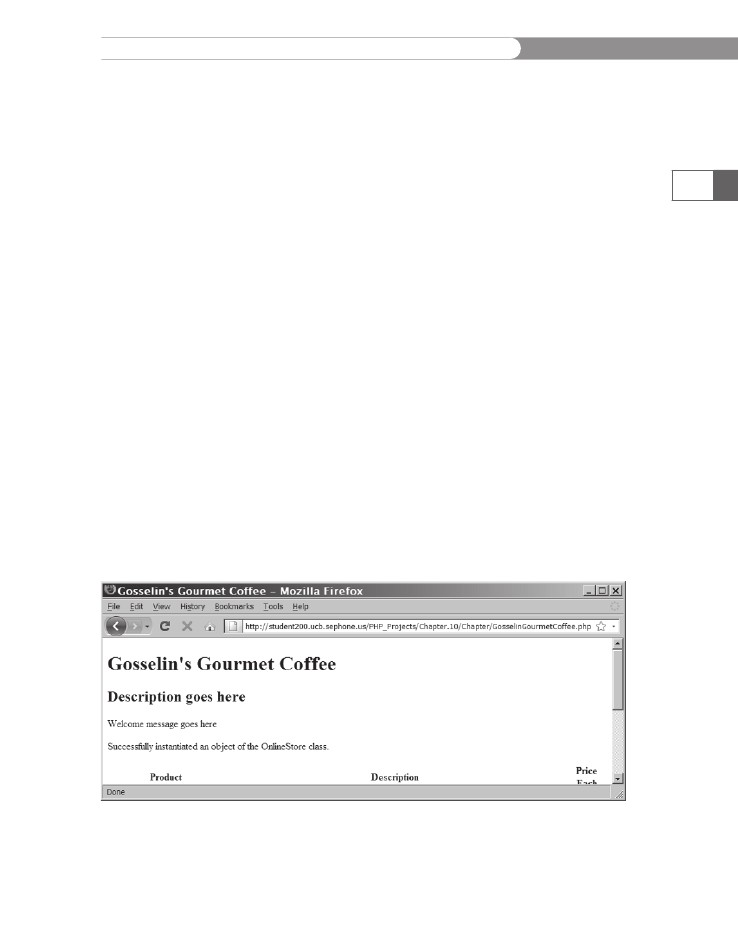
- •Initializing with Constructor Functions . . . . .
- •Into a Web page as a separate section. Although JavaScript code can
- •Is that standard php script delimiters are guaranteed to be available
- •In the block. Any text or lines between the opening /* characters and
- •2.7541 Are not integers; they are floating-point numbers. A floating-
- •Value 300
- •Is a value of 2.5, because 6 goes into 15 exactly 2.5 times. But if you
- •IsEven.Php.
- •Ing example,
- •Ing curly brace is on its own line following the function statements.
- •In php 3 and earlier, it was necessary to put a function definition
- •Is called an iteration. When the conditional expression evaluates
- •Including Files
- •13. Close your Web browser window.
- •Including Files
- •In php, you can also use two operators to combine strings. The first
- •Xhtml source code gen-
- •Input. Php provides several functions for manipulating the case of a
- •Is uppercase. If you need the reverse of ucfirst(), the lcfirst()
- •In some situations, you will need to find and extract characters and
- •Information Interchange, or ascii, which are numeric represen-
- •In comparison, the following preg_match() function returns a value
- •In the pattern is optional. The following code demonstrates how to
- •Values; any strings you validate against a regular expression must
- •Value of 1 because the top-level domain contains a valid value of .Com.
- •Is submitted using the “post” method, the form data is embedded in
- •Validating String Data
- •Xhtml tags or character entities. The message field is a text string
- •Value of the header element. For example:
- •Xhtml code within a php script section.
- •Is typically the person who created the resource. Otherwise, the net-
- •If even a single character of the Web page is sent prior to sending
- •Variables to the file_put_contents() function.
- •Xhtml hyperlink. To download a file from outside the xhtml
- •If...Else statement to display the appropriate version of the mes-
- •Iterating Through an Array
- •Iterating Through an Array
- •In Chapter 2, you learned how to use a foreach statement to iterate
- •Iterating Through an Array
- •Iterating Through an Array
- •In comparison, the following code declares and initializes
- •If ((!file_exists("MessageBoard/messages.Txt"))
- •Values from the array to create a thumbnail gallery of images in which
- •Introduction to Databases
- •Including php, allow you to create Web pages that can read and write
- •Introduction to Databases
- •Information that can be organized into ordered sets of data, and
- •Information. Each recipe in a recipe database, for instance, is a single
- •Introduction to Databases
- •Index, which identifies records in a database to make retrievals and
- •In a single table. However, you might want to break the information
- •Into multiple tables to better organize it into logical sets. Another
- •Information in one of the tables confidential and accessible only by
- •Is the employee information table from Figure 7-1. The related table
- •Is a payroll table that contains confidential salary and compensation
- •Information. Notice that each table contains an identical number of
- •Introduction to Databases
- •Introduction to Databases
- •In a junction
- •Introduction to Databases
- •In a relational format is called a relational database management
- •Is a standard data manipulation language among many dbmSs.
- •Into the query area at the top of the screen or by dragging tables and
- •It is important to understand that even though many dbmSs sup-
- •Introduction to Databases
- •If you ever
- •Is. In comparison, the bigint data type stores integer values between
- •5 Rows in set (0.00 sec)
- •Int);[enter ]
- •Important, these two tabs can cause you to lose all of the data in the
- •Internet Explorer to export the table, click the Save button in the File
- •Ifies the table being changed and the change to make.
- •It easier for you to write php code that can be used with a variety of
- •Information about queries that match one of the following formats:
- •Various types of actions, depending on the type of query.
- •Include fields for the date and time of the flight, flight number, and
- •In the ChineseZodiac folder and upload the file to the server. Open
- •Including white space,
- •Information on a Web server. When you start a new session, the
- •Introduction to Object-Oriented Programming
- •Introduction to Object-Oriented
- •Variables associated with an object are called properties or attributes.
- •In the Loan object example, a function that calculates the number of
- •Introduction to Object-Oriented Programming
- •Introduction to Object-Oriented Programming
- •Include instances of objects inherit the object’s functionality.
- •In this chapter, you will create the Web site for an online order form
- •In an online store application. The application includes information
- •Ity of building a working online store. Online store classes are very
- •Information and products. The OnlineStore class requires that store
- •Information is stored in a table containing six fields: storeId, name,
- •Information. Instead, the class simply uses session iDs to keep track
- •Variable and function as necessary, without bothering with all this
- •In a class
- •Is developed. Imagine what would happen if Microsoft distributed
- •Ing class is invalid because it does not include an access specifier:
- •If they will not be supported by future xhtml versions or are not
- •Xhtml standards. To review the guide of current w3c css specifi-
- •Information to remind yourself or others of what the code is doing. A
- •Xhtml document to the external style sheet. This link informa-
- •If you select Apache from the WampServer menu and select Service
- •Ing code uses the number_format() function to add comma separa-
- •In data that a user submits to a php script.
- •Value of “On” and the display_startup_errors directive is assigned
- •Instead. By looking at the source code, you could see that the value of
- •Ing engine can even help locate logic errors.
- •In Chapter 8, along with the equivalent mssql_* functions, where
- •Inline styles, 632
- •Xhtml, 620–635 (continued)
CHAPTER
10
Developing
Object-Oriented PHP
574
members
of different data types, so calling a class a data type becomes
even
more confusing. One reason classes are called user-defined data
types
or programmer-defined data types is that you can work with a
class
as a single unit, or object, in the same way you work with a vari-
able.
In fact, the terms “variable” and “object” are often used
inter-
changeably
in object-oriented programming. The term “object-oriented
programming”
comes from the fact that you can bundle variables and
functions
together and use the result as a single unit (a variable or
object).
This
information will become clearer to you as you progress through
this
chapter. For now, think of the handheld calculator example. A
calculator
could be considered an object of a Calculation
class.
You
access
all of the Calculation
class
functions (such as addition and
subtraction)
and its data members (operands that represent the num-
bers
you are calculating) through your calculator object. You never
actually
work with the Calculation
class
yourself, only with an object
of
the class (your calculator).
But
why do you need to work with a collection of related variables
and
functions as a single object? Why not simply call each individual
class
business? The truth is, you are not required to work with classes;
you
can create much of the same functionality without classes as you
can
by using classes. In fact, many of the scripts that you create—and
that
you find in use today—do not require object-oriented techniques
to
be effective. Classes help make complex programs easier to man-
age,
however, by logically grouping related functions and data and
by
allowing you to refer to that grouping as a single object. Another
reason
for using classes is to hide information that users of a class do
not
need to access or know about; this helps minimize the amount of
information
that needs to pass in and out of an object. Classes also
make
it much easier to reuse code or distribute your code to others
for
use in their programs. (You will learn how to create your own
classes
and include them in your scripts shortly.) Packaging related
variables
and functions into a class is similar to packaging them into a
single
include file, then using the include()
statement
to insert them
in
a PHP script. The difference is that an include file can only
contain
a
single copy of each variable, whereas each instance of a class will
contain
a distinct copy of each variable.
Another
reason to use classes is that instances of objects inherit their
characteristics,
such as class members, from the class upon which
they
are based. This inheritance allows you to build new classes based
on
existing classes without having to rewrite the code contained in
the
existing classes.Variable and function as necessary, without bothering with all this

Using
Objects in PHP Scripts
Creating
a Class Definition
To
create a class in PHP, you use the class
keyword
to write a class
definition,
which contains the data members and member functions
that
make up the class. The basic syntax for defining a class is as
follows:
class
ClassName {
data
member and member function definitions
}
575
The ClassName portion of the class definition is the name of the new
class. You can use any name you want for a structure, as long as you
follow the same naming conventions that you use when declaring
other identifiers, such as variables and functions. Also, keep in mind
that class names usually begin with an uppercase letter to distinguish
them from other identifiers. Within the class’s curly braces, you
declare the data type and field names for each piece of information
stored in the structure, the same way you declare data members and
member functions that make up the class.
The following code demonstrates how to declare a class named
BankAccount. The statement following the class definition instantiates
an object of the class named $Checking.
class BankAccount {
data member and member function definitions
}
$Checking = new BankAccount();
Class names
In a class
definition are
not followed
by parenthe-
ses, as function names
are in a function
definition.
Because the BankAccount class does not yet contain any data mem-
bers or member functions, there isn’t much you can do with the
$Checking object. However, PHP includes a number of built-in
functions that you can use to return information about the class
that instantiated the object. For example, the get_class() function
returns the name of the class that instantiated the object. You pass the
name of the object to the get_class() function, as follows:
$Checking = new BankAccount();
echo 'The $Checking object is instantiated from the '
. get_class($Checking) . " class.</p>\n";
See the
Class/Object
Functions
reference in
the online PHP
documentation at http://
www.php.net/docs.php
for more information on
the functions you can use
with classes and objects.
You can also use the instanceof comparison operator to deter-
mine whether an object is instantiated from a given class. The syn-
tax for using the instanceof operator is object_name instanceof
class_name. For example, the following code uses an if statement
and the instanceof operator to determine whether the $Checking
object is an instance of the BankAccount class:
$Checking = new BankAccount();
if ($Checking instanceof BankAccount)
echo "The \$Checking object is instantiated from the
BankAccount class.</p>\n";

CHAPTER
10
Developing
Object-Oriented PHP
576
One
built-in class function that you should use whenever you declare
an
object is the class_exists()
function,
which determines whether
a
class exists and is available to the current script. You pass to the
class_exists()
function
a string value containing the name of the
class
you want to use. The function returns a value of TRUE
if
the class
exists
and FALSE
if
it doesn’t. For example, the following code uses
the
class_exists()
function
within an if
statement’s
conditional
expression
to check for the existence of the BankAccount
class.
If the
class
exists, the $Checking
object
is instantiated. If the class does not
exist,
the else
clause
displays an error message.
if
(class_exists("BankAccount"))
$Checking
= new BankAccount();
else
echo "<p>The BankAccount class is not available!</p>\n";
Storing Classes in External Files
Just as you
preface the
names of
include files
with “inc_” to
easily distinguish them
from regular PHP files,
you can preface the
name of class files with
“class_”, as in “class_
BankAccount.php”.
Although you can define a class within the same document that
instantiates an object of the class, this somewhat defeats the purpose
of writing code that can be easily modified and reused. If you want
to reuse the class, you need to copy and paste it between scripts.
Further, if you want to modify the class, you need to modify it
within every script that uses it. A better solution is to define a class
within a single external file that is called from each script that needs
the class, using the include(), include_once(), require(), and
require_once() functions that you learned in Chapter 2.
To start creating the OnlineStore class and using it in
GosselinGourmetCoffee.php:
1.
Create a new document in your text editor and add a PHP
script section, as follows:
<?php
?>
2.
Add the following class definition for the OnlineStore class
to the script section:
class OnlineStore {
}
3.
Save the document as class_OnlineStore.php in the Chapter
directory for Chapter 10.
Return to the GosselinGourmetCoffee.php script in your
text editor.
Add the following statement to the PHP script section at the
beginning of the file, beneath the require_once() statement
for inc_OnlineStoreDB.php. This statement uses another
4.
5.

Using
Objects in PHP Scripts
require_once()
statement
that makes the OnlineStore
class
available
to the GosselinGourmetCoffee.php script.
require_once("class_OnlineStore.php");
6.
Add
the following statements beneath the statement that
includes
the OnlineStore
class
file. These statements instanti-
ate
an object of the OnlineStore
class.
if
(class_exists("OnlineStore")) {
$Store
= new OnlineStore();
}
else {
$ErrorMsgs[] = "The OnlineStore class is not
available!";
$Store = NULL;
}
577
7.
Add the following statements to the start of the PHP script
section in the body of the document, immediately before the
if statement that queries the database:
if ($Store !== NULL)
echo "<p>Successfully instantiated an object of " .
" the OnlineStore class.</p>\n";
8.
Save the GosselinGourmetCoffee.php script and then upload
both documents to the Web server.
Open the GosselinGourmetCoffee.php script in your Web
browser by entering the following URL: http://<yourserver>/
PHP_Projects/Chapter.10/Chapter/GosselinGourmetCoffee.
php. You should see the message shown in Figure 10-6.
9.
Figure 10-6
10.
Gosselin’s Gourmet Coffee Web page after instantiating an OnlineStore object
Close your Web browser window.

CHAPTER
10
Developing
Object-Oriented PHP
Collecting
Garbage
If
you have worked with other object-oriented programming lan-
guages,
you might be familiar with the term garbage
collection,
which
refers to cleaning up, or reclaiming, memory that is reserved
by
a program. When you declare a variable or instantiate a new
object,
you are actually reserving computer memory for the vari-
able
or object. With some programming languages, you must write
code
that deletes a variable or object after you finish with it. This
frees
the memory for use by other parts of your program or by other
programs
running on your computer. With PHP, you do not need to
worry
about reclaiming memory that is reserved for your variables or
objects.
Although you can manually remove a variable or object with
the
unset()
function,
there is usually no reason to do so—as with
variables,
PHP will automatically clean up unused memory when
an
object within a function goes out of scope, or at the end of the
script
for global objects. The one exception involves open database
connections.
As you learned in Chapter 8, because database con-
nections
can take up a lot of memory, you should explicitly close a
database
connection when you finish with it by calling the procedural
mysql_close()
function
or the close()
method
of the mysqli
class.
This
ensures that the connection doesn’t keep taking up space in your
computer’s
memory while the script finishes processing.
578
Short
Quiz
1.
2.
Illustrate
the syntax of instantiating an object.
What
operator is used to access the methods and properties
contained
in an object?
What
function of the mysqli
object
is used to determine if a
database
connection failed?
Illustrate
the syntax used to define a PHP class.
Explain
the term “garbage collection.”
3.
4.
5.
Declaring
Data Members
In
this section, you will learn how to declare data members within a
class.
Declaring and initializing data members is a little more involved
than
declaring and initializing standard PHP variables. To be able
to
declare data members, you must first understand the principle of
information
hiding, which you will study first.
